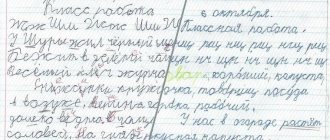This work is devoted to the problem of dysgraphia and dyslexia as a specific disorder of the written speech of primary schoolchildren.
This topic is relevant both for speech therapy and for pedagogy in general, since the child’s future acquisition of literacy and adaptation in the child’s society depends on the level of development of the writing process and the reading process in the child.
It should be noted that reading and writing disorders are the most common forms of speech pathology in primary schoolchildren.
The purpose of the essay is to describe specific violations of the written language of primary schoolchildren.
Tasks:
- Describe the concepts of “dysgraphia” and “dyslexia”.
- Consider the etiology of written language disorders.
3.Describe methods for correcting written language impairment in primary schoolchildren.
To write the work, the experience of domestic teachers and speech therapists was used: M. E. Khvattsev, R. I. Lalaeva, A. N. Kornev and other researchers.
THE CONCEPT OF DYGRAPHIA AND DYSLEXIA
Dysgraphia and dyslexia are the inability (or difficulty) of mastering reading and writing with intact intelligence and physical hearing.
A. Kussmaul was the first to point out these disorders as an independent pathology of speech activity in 1877. Then many other works appeared in which descriptions were given of children with various reading and writing disorders.
In the 30s of the 20th century, reading and writing disorders began to be studied by psychologists, teachers, and defectologists.
The content of the term “dysgraphia” is defined differently in modern literature.
R.I. Lalaeva gives the following definition: dysgraphia is a partial violation of the writing process, manifested in persistent, repeated errors caused by the immaturity of the higher mental functions involved in the writing process.
I. N. Sadovnikova defines dysgraphia as a partial writing disorder (for younger schoolchildren, difficulties in mastering written language).
A. N. Kornev calls dysgraphia the persistent inability to master writing skills according to the rules of graphics.
A. L. Sirotyuk defines dysgraphia as a partial impairment of writing skills due to focal damage, underdevelopment or dysfunction of the cerebral cortex.
In the textbook by L. S. Volkova the following definition is given:
“Dysgraphia is a partial, specific disorder of the writing process.”
O. V. Pravdina believes that one of the differences between written and oral speech is additional means of expressing the meanings of language. Understanding oral speech is facilitated by the expressiveness of speech, facial expressions and gestures of the speaker, as well as the general situation in which speech is realized.
In the process of writing, all this is replaced by dividing speech into words, using punctuation marks, a red line, a capital letter, different spellings of words that sound the same but have different meanings, underlining, highlighting in a special font, as well as drawings, tables accompanying the text, and, of course, connection with the entire text.
Oral speech is formed first, and written speech - a superstructure over already mature oral speech - uses all its ready-made mechanisms, improving and significantly complicating them, adding to them new mechanisms specific to the new form of language expression.
Automated hand movements are the final step in the complex process of translating spoken language into written language.
A. R. Luria defines the following writing operations:
A letter begins with an incentive, a motive, a task.
One of the most complex operations in the writing process is the analysis of the sound structure of a word.
The next operation is the correlation of a phoneme isolated from a word with a certain visual image of a letter, which must be differentiated from all others, especially from graphically similar ones.
Then follows the motor operation of the writing process - reproduction of the visual image of the letter using hand movements. Simultaneously with the movement of the hand, kinesthetic control is carried out.
The lack of development of any of these functions can cause a disruption in the process of mastering writing, dysgraphia.
Signs that characterize dysgraphia include typical and repeated errors in writing of a persistent nature, not related to ignorance of the rules and norms of the language.
In addition, with dysgraphia, children write slowly, and their handwriting is usually difficult to distinguish. There may be fluctuations in the height and inclination of letters, slippage from the line, replacement of capital letters with lowercase ones and vice versa. We can talk about the presence of dysgraphia only after the child masters the technique of writing, i.e. not earlier than 8–8.5 years.
Quite often, with dysgraphia, non-speech symptoms are detected: neurological disorders, decreased performance, distractibility, hyperactivity, decreased memory capacity, etc.
Dyslexia is also classified as a written language disorder.
R.I. Lalaeva gives the following definition: dyslexia is a partial specific disorder of the reading process, caused by the immaturity (impairment) of higher mental functions and manifested in repeated errors of a persistent nature.
A. N. Kornev, speaking of dyslexia, means conditions the main manifestation of which is a persistent selective inability to master the skill of reading, despite a sufficient level of intellectual and speech development for this, the absence of disorders of the auditory and visual analyzers and optimal learning conditions.
Dyslexia is a partial specific disorder of the reading process, caused by the immaturity (impairment) of higher mental functions and manifested in repeated persistent errors.
Reading begins with visual perception, discrimination and recognition of letters. On this basis, letters are correlated with the corresponding sounds and the sound-pronunciation image of the word is reproduced and read. Due to the correlation of the sound form of a word with its meaning, understanding of what is being read is achieved.
In the reading process, we can conditionally distinguish two sides: technical (correlating the visual image of a written word with its pronunciation) and semantic, which is the main goal of the reading process.
Understanding “is carried out on the basis of the sound form of the word with which its meaning is associated.”
There is a close, inextricable connection between these aspects of the reading process.
T. G. Egorov identifies the following stages in the formation of reading skills:
1) mastery of sound-letter notations;
2) syllable reading;
3) the formation of synthetic reading techniques;
4) synthetic reading.
Each of them is characterized by originality, qualitative features, a certain psychological structure, its own difficulties and tasks, as well as methods of mastery.
Reading errors in dyslexia are persistent, and without special correction work they can persist in a child for many months and years.
The dynamics of dyslexia are regressive in nature with a gradual decrease in the types and number of errors in reading, and the degree of severity.
Thus, the concept of written speech includes reading and writing as equal components. “Writing is a symbolic system for recording speech, which allows, with the help of graphic elements, to transmit information at a distance and consolidate it in time. Any writing system is characterized by a constant composition of characters.”
Lack of development of functions can cause a disruption in the process of mastering writing and reading.
Dysgraphia, like dyslexia, in children with normal intelligence can cause various deviations in personality formation and certain mental layers.
Causes of the disease
In children
Causes of dysgraphia in children:
- Perinatal pathologies; heredity; illnesses and injuries in infancy
- Teaching foreign languages at an early age; bilingual or multilingual family
- Authoritarian parenting methods
- Limitation of speech communication in the family; “Lisping”, unclear pronunciation of words by adults
- TV abuse
- Neurological complications; disorder of attention, memory; dyslexia (reading disorder)
- Retraining a left-handed child
- Start of schooling at age 6
In adults
Dysgraphia in adults is caused by the following reasons:
- Traumatic brain injuries
- Strokes, brain tumors
- Meningitis
- Neurosurgical interventions
- Injuries sustained during childbirth
- Post-existing asphyxia
Dysgraphia
ETIOLOGY OF WRITTEN SPEECH DISORDERS
The modern understanding of this issue comes down to the recognition that the main factor causing dyslexia and dysgraphia is a predisposition to it (constitutional features).
The constitution refers to a number of features of the body: immunity, potential resources of various physical processes, the nature of brain neurodynamics, pathoplastic organic background (previous diseases of the central nervous system), etc.
However, in order for these prerequisites to lead to a pathological inability to learn to read and write, special living conditions are necessary that provoke the “pre-illness” stage to develop into a disease
The issue of the etiology of dyslexia is still controversial.
Reinhold believes that there is a special, congenital form of dyslexia, when children inherit from their parents qualitative immaturity of the brain in its individual zones. This immaturity manifests itself in specific delays in the development of a certain function.
Most authors note the presence of pathological factors affecting the prenatal, natal and postnatal periods.
Reading disorders can be caused by organic and functional reasons. Dyslexia is caused by organic damage to areas of the brain involved in the reading process (for example, with aphasia, dysarthria, alalia).
Functional reasons may be associated with the influence of internal and external factors that delay the formation of mental functions involved in the reading process.
Dyslexia in children with relatively intact intelligence is a partial delay in mental development, which is characterized by a number of features: combination with mental infantilism, pronounced unevenness of mental development, certain features of the structure of intelligence, underdevelopment of successive and simultaneous processes, impairment of short-term speech-auditory memory, etc. d.
Based on their manifestation, there are two types:
- literal, manifested in the inability or difficulty of mastering letters;
- verbal, which manifests itself in difficulties reading words.
O. A. Tokareva classifies reading disorders depending on which of the analyzers is primarily impaired: auditory, visual or motor. And in this regard, he distinguishes acoustic, optical and motor forms of dyslexia.
Acoustic disturbances are observed both in cases of oral speech disorder (dysarthria, dyslalia) and in cases of delayed speech development.
Clear acoustic perception is one of the necessary conditions for the formation of oral and written speech. One of the necessary prerequisites for the development of reading is the ability to isolate a phoneme from the entire variety of sounds as a specific generalization of the semantic distinctive features of a sound, and to correlate it with a specific symbol.
Optical dyslexia is characterized by instability of visual perception and ideas. Individual letters are poorly absorbed, connections between its visual image and sound are not established, there is no clear visual image of the letter, therefore the same letter is perceived differently. There is a frequent confusion of letters that are similar in style, and visual recognition of words when reading is impaired (verbal dyslexia).
With motor dyslexia, there is difficulty moving the eyes when reading.
The act of reading is carried out only under the condition of coordinated, interconnected work of the visual, auditory and motor analyzers. Coordination disorders of these analyzers cause various reading disorders.
Based on impaired mechanisms, M.E. Khvattsev distinguishes phonemic, optical, optical-spatial, semantic and mnestic dyslexia.
M. E. Khvattsev’s classification does not take into account all operations of the reading process. The presented types of dyslexia in children do not cover all cases of reading disorders.
Taking into account the impaired operations of the reading process, R. I. Lalaeva identifies the following types of dyslexia: phonemic, semantic, agrammatic, mnestic, optical, tactile.
Phonemic dyslexia is associated with underdevelopment of the functions of the phonemic system.
Semantic dyslexia (mechanical reading) manifests itself in a violation of the understanding of words, sentences, and texts read with technically correct reading.
Agrammatical dyslexia is caused by underdevelopment of the grammatical structure of speech, morphological, and syntactic generalizations.
Mnestic dyslexia manifests itself in difficulties in learning letters and in their undifferentiated substitutions. It is caused by a violation of the processes of establishing connections between sounds and letters and a violation of speech memory.
Optical dyslexia manifests itself in difficulties in learning and in mixing similar graphic letters and their mutual substitutions. Letters are mixed and interchanged, as they differ in additional elements.
In literal optical dyslexia, impairments are observed in isolated letter recognition and discrimination.
In verbal dyslexia, impairments occur when reading words.
With organic brain damage, mirror reading can be observed.
Tactile dyslexia is observed in blind children. It is based on the difficulties of differentiating tactilely perceived Braille letters. During the reading process, there are mixtures of tactilely similar letters consisting of the same number of dots, dots located mirrored above or below, or differing by one dot.
The causes of reading and writing disorders are similar.
The psycholinguistic aspect of the study of dysgraphia is not sufficiently represented in the speech therapy literature. This aspect considers the mechanisms of writing disorders as a disorder of the operations of generating a written speech utterance.
There are several classifications of childhood dysgraphia, reflecting the different state of science at the time of their development, and also indicating a different understanding by the authors of the mechanisms of this disorder (M. E. Khvattsev, 50s of the 20th century; O.A. Tokareva, 60s; R.I. Lalaeva and staff of the Department of Speech Therapy of the Russian State Pedagogical University named after A.I. Herzen, 70-80s; A.N. Kornev, 90s, T.V. Akhutina, beginning of the 21st century).
From the perspective of a psychophysiological approach, dysgraphia is considered as a consequence of a violation of the analytical and synthetic activity of analyzers.
Characterizing the causes and mechanisms of dysgraphia, O.A. Tokareva says that the primary underdevelopment of analyzers and inter-analyzer connections leads to insufficient analysis and synthesis of multimodal perceptual information, a violation of the recoding of sensory information from one modality to another.
Classifies types of dysgraphia:
- Acoustic dysgraphia is associated with insufficiency of phonemic hearing, in which the differentiation of phonemes suffers and the establishment of correct sound-letter correspondences is impaired.
- Motor dysgraphia is caused by defective activity of the motor analyzer, which is accompanied by the development of pathological inertia in the formation of motor stereotypes.
- Optical dysgraphia is associated with underdevelopment of the visual systems of the cerebral cortex in children. The inferiority of the optical analyzer can manifest itself in a violation of holistic perception, differentiated visual representations, and visual memory.
M.E. Khvattsev and R.E. Levina were among the first researchers who associated dysgraphia primarily with insufficient language development in children. The classification of M. E. Khvattsev is currently not used in the practical activities of speech therapists, but its role in the development of the doctrine of childhood dysgraphia is very great.
The scientist identified five types of dysgraphia, two of which - dysgraphia due to oral speech disorders (tongue-tied writing) and optical dysgraphia - are also present in the modern classification.
From the perspective of a clinical-psychological (medical-psychological) approach, dysgraphia is often considered not as an independent disorder, but as one of the symptoms included in a complex of other, mainly neurological or encephalopathic disorders (S. S. Mnukhin; Yu. G. Demyanov; I. F. Markovskaya; A. N. Kornev).
Thus, the causes of reading and writing disorders are similar.
It is impossible to talk about single etiological factors that cause difficulties in mastering reading and writing, since dyslexia and dysgraphia are heterogeneous, i.e. there is a sufficient variety of their forms.
How does the disease manifest itself?
In children
The main symptom of dysgraphia is a lot of persistent errors in written work. The child mistakenly interprets sounds in the strong position of letters: for example, he writes “prafy” instead of “right.” In short words, letters are missing: “house” is written as “dm”. Syllables are swapped and extra ones are added. The recordings confuse paired consonants and similar elements of letter symbols.
The speed of writing is slow; time is spent thinking about what and how to write. Another option is a quick but illiterate recording of words. It is difficult for dysgraphics to reproduce in a notebook what is written on the board. Confused letters in words occur due to the inability to distinguish sounds by ear. Parents and teachers should be wary of the repetition of mistakes made when writing.
According to medical observations, dysgraphia is diagnosed in parallel with hyperactivity and neurological problems.
In adults
An adult suffering from dysgraphia, knowing the grammatical rules, makes the same mistakes when writing:
- mixing elements of similar letters (sh-ts-sch; p-t-l; ъ-ь);
- replacement of similar-sounding graphemes (p-b, k-x);
- confusion between the unity and separation of words;
- randomness of syllables, missing letters;
- Slow recording speed, unclear handwriting.
Disturbances in brain processes in a patient with dysgraphia manifest themselves not only in errors in written speech. Fine motor skills and memory mechanisms deteriorate. A person is easily distracted and has difficulty concentrating. An important fact: the accumulated stock of knowledge does not disappear from memory, the level of intelligence remains the same.
How to organize classes at home
How can parents prevent dysgraphic disorders in their children? Prevention of dysgraphia begins with pregnancy. The mother needs to take care of herself and the baby, avoid the risk of infections and injuries in the child’s early childhood. From infancy, children are emotionally dependent on their parents. It is necessary to avoid stress and create a warm atmosphere in the family.
The foundations for successful writing skills are laid in the preschool period. By learning poems and songs, the baby learns to hear sounds and relate sounds to letters. Visual perception is trained by games where colors and shapes are compared. Construction sets with large details, modeling, and appliqué develop spatial thinking and motor skills.
Drawing along the contour and filling out copybooks for preschoolers will prepare the child's hand for writing. The magnetic alphabet can be easily placed on the refrigerator at home. By sorting through the squares, the child remembers the external outlines of letter symbols, the sequence of letters, sounds in words.
If a speech therapist diagnoses a defect in the development of speech skills, you must not miss the moment and correct the violations. By developing oral speech, a junior student will easily master written speech.






